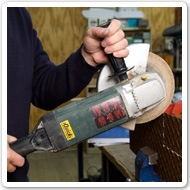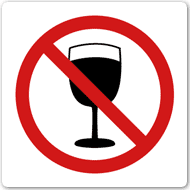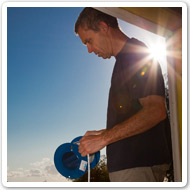Types of hazards
Following are information and questions relating to physical and psychological hazards.
Instructions:
For the six questions:
- choose the correct answer
- write down your answer.
1. The following image shows a person using an angle grinder.

What type of hazard is shown in the image?
- Heat.
- UV radiation.
- Vibration.
- Stress.
Answer:
Using a grinder can cause vibration to the hand/arm area.
Information about vibration
High levels of regular vibration to part or all of a person's body can cause permanent injury.
The level of injury depends on:
- exposure time
- frequency of vibration
- size of vibration.
Limit exposure to vibration and use equipment with dampening to reduce dangers from vibration.
2. The following image shows a person holding his head and appearing frustrated/upset/unhappy.

What do you think this worker may be suffering from?
- Electrocution.
- UV radiation.
- Vibration.
- Stress.
Answer:
The frustrated look of the worker indicates they may be suffering from stress.
Information about stress
Stress can be a result of many things including;
- long work hours
- harassment
- poor work practices
Exposure to stress can have physical and emotional results including;
- loss of motivation
- headaches
- loss of weight
- sleep difficulties
3. The following image shows a sign representing no drinking.

The image shown represents what type of workplace hazard?
- Drugs and alcohol.
- UV radiation.
- Vibration.
- Stress.
Answer:
The image represents drugs and alcohol.
Information about drugs and alcohol
Drugs or alcohol and the workplace do not mix.
Under the influence of drugs or alcohol a person's performance and ability to make decisions are reduced. This can lead to serious accidents.
4. The following image shows a worker using a screwdriver.

What type of hazard is shown in the image?
- Vibration.
- UV radiation.
- Overuse syndrome.
- Stress.
Answer:
Continual repetitive actions such as using a screwdriver can result in overuse syndrome.
Information about overuse syndrome
Also known as repetitive strain injury (RSI), overuse syndrome occurs as a result of repetition of body movement or holding the body in an uncomfortable position for lengths of time.
An example of this is fitting of power points or lights using a screwdriver.
Overuse can result in injury to muscles, tendons and joints.
Good work practices can limit exposure to overuse syndrome.
5. The following image shows a worker outside, dressed in shorts and t-shirt.

What type of hazard is this worker exposed to?
- Vibration.
- UV radiation.
- Overuse syndrome.
- Stress.
Answer:
Working in the sun exposes a person to ultra violet (UV) radiation.
Information about ultra violet (UV) radiation
Outdoor workers are in danger of the effects of UV radiation.
This form of radiation is known to cause skin cancers.
Sun protection should be followed including limiting time exposure to the sun, wearing appropriate clothing and head wear, and using sunscreen.
6. The following image shows a worker placing wire in a switchboard.

What type of hazard is this worker exposed to?
- Electrocution.
- UV radiation.
- Vibration.
- Stress.
Answer:
Electricians are often in danger of electrocution.
Information about electrocution
Electricians must constantly be aware of the dangers of electricity.
High or low voltages can cause serious injury or death.
Before working on any electrical equipment all sources of voltage must be isolated.
When you have finished:
- show your answers to your trainer
- close this window and choose a new activity from the menu.